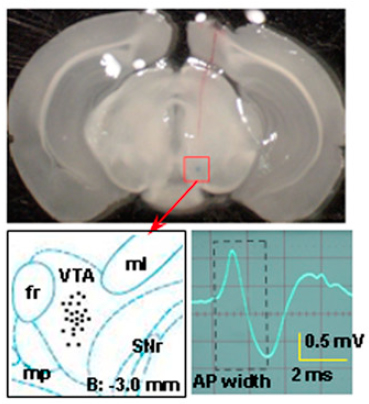Hot Off the Press! – November 2014

Zhang, Hai-Ying; Gao, Ming; Liu, Qing-Rong; Bi, Guo-Hua; Li, Xia; Yang, Hong-Ju; Gardner, Eliot L; Wu, Jie; Xi, Zheng-Xiong
Cannabinoid CB2 receptors modulate midbrain dopamine neuronal activity and dopamine-related behavior in mice. Journal Article
In: Proc Natl Acad Sci U S A, vol. 111, no. 46, pp. E5007-15, 2014, ISSN: 1091-6490 (Electronic); 0027-8424 (Linking).
@article{Zhang2014b,
title = {Cannabinoid CB2 receptors modulate midbrain dopamine neuronal activity and dopamine-related behavior in mice.},
author = {Hai-Ying Zhang and Ming Gao and Qing-Rong Liu and Guo-Hua Bi and Xia Li and Hong-Ju Yang and Eliot L Gardner and Jie Wu and Zheng-Xiong Xi},
url = {https://www.ncbi.nlm.nih.gov/pubmed/25368177},
doi = {10.1073/pnas.1413210111},
issn = {1091-6490 (Electronic); 0027-8424 (Linking)},
year = {2014},
date = {2014-11-18},
journal = {Proc Natl Acad Sci U S A},
volume = {111},
number = {46},
pages = {E5007-15},
address = {Intramural Research Program, National Institute on Drug Abuse, Baltimore, MD 21224;},
abstract = {Cannabinoid CB2 receptors (CB2Rs) have been recently reported to modulate brain dopamine (DA)-related behaviors; however, the cellular mechanisms underlying these actions are unclear. Here we report that CB2Rs are expressed in ventral tegmental area (VTA) DA neurons and functionally modulate DA neuronal excitability and DA-related behavior. In situ hybridization and immunohistochemical assays detected CB2 mRNA and CB2R immunostaining in VTA DA neurons. Electrophysiological studies demonstrated that activation of CB2Rs by JWH133 or other CB2R agonists inhibited VTA DA neuronal firing in vivo and ex vivo, whereas microinjections of JWH133 into the VTA inhibited cocaine self-administration. Importantly, all of the above findings observed in WT or CB1(-/-) mice are blocked by CB2R antagonist and absent in CB2(-/-) mice. These data suggest that CB2R-mediated reduction of VTA DA neuronal activity may underlie JWH133's modulation of DA-regulated behaviors.},
keywords = {},
pubstate = {published},
tppubtype = {article}
}
Cannabinoid CB2 receptors (CB2Rs) have been recently reported to modulate brain dopamine (DA)-related behaviors; however, the cellular mechanisms underlying these actions are unclear. Here we report that CB2Rs are expressed in ventral tegmental area (VTA) DA neurons and functionally modulate DA neuronal excitability and DA-related behavior. In situ hybridization and immunohistochemical assays detected CB2 mRNA and CB2R immunostaining in VTA DA neurons. Electrophysiological studies demonstrated that activation of CB2Rs by JWH133 or other CB2R agonists inhibited VTA DA neuronal firing in vivo and ex vivo, whereas microinjections of JWH133 into the VTA inhibited cocaine self-administration. Importantly, all of the above findings observed in WT or CB1(-/-) mice are blocked by CB2R antagonist and absent in CB2(-/-) mice. These data suggest that CB2R-mediated reduction of VTA DA neuronal activity may underlie JWH133's modulation of DA-regulated behaviors.
